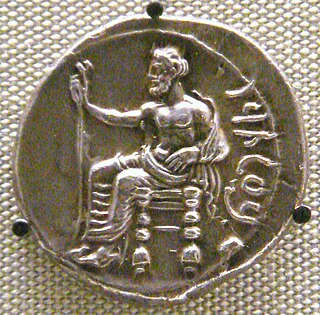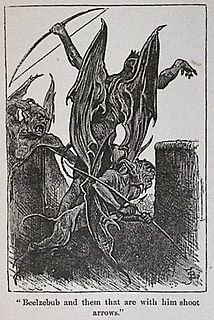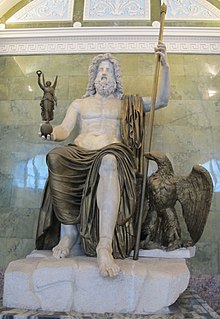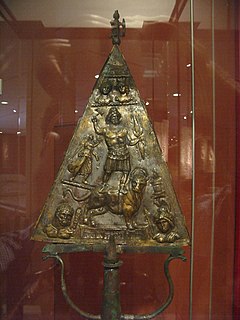 W
WBaal, properly Baʽal, was a title and honorific meaning "owner", "lord" in the Northwest Semitic languages spoken in the Levant during antiquity. From its use among people, it came to be applied to gods. Scholars previously associated the theonym with solar cults and with a variety of unrelated patron deities, but inscriptions have shown that the name Baʿal was particularly associated with the storm and fertility god Hadad and his local manifestations.
 W
WThe Baal Cycle is an Ugaritic cycle of stories about the Canaanite god Baʿal, a storm god associated with fertility. It is one of the Ugarit texts.
 W
WBaal Hammon, properly Baʿal Ḥammon or English: “Lord Hammon” Ḥamon, was the chief god of Ancient Carthage. He was a weather god considered responsible for the fertility of vegetation and esteemed as King of the Gods. He was depicted as a bearded older man with curling ram's horns. Baʿal Ḥammon's female cult partner was Tanit.
 W
WBaalshamin, also called Baal Shamem and Baal Shamaim, was a Northwest Semitic god and a title applied to different gods at different places or times in ancient Middle Eastern inscriptions, especially in Canaan/Phoenicia and Syria. The title was most often applied to Hadad, who is also often titled just Ba‘al. Baalshamin was one of the two supreme gods and the sky god of pre-Islamic Palmyra in ancient Syria. There his attributes were the eagle and the lightning bolt, and he perhaps formed a triad with the lunar god Aglibol and the sun god Malakbel.
 W
WBaal with Thunderbolt or the Baal stele is a white limestone bas-relief stele from the ancient kingdom of Ugarit in northwestern Syria. The stele was discovered in 1932, about 20 metres (66 ft) from the Temple of Baal in the acropolis of Ugarit, during excavations directed by French archaeologist Claude F. A. Schaeffer. The stele depicts Baal, the Aramean god of storm and rain, and is considered the most important of the Ugaritic stelae. The stele is on display at the Musée du Louvre in Paris.
 W
WBaaltars was the tutelary deity of the city of Tarsus in the Persian Empire. His depiction appears on coins of the Persian governors (satraps) of Cilicia at Tarsus before the conquests of Alexander the Great, in the 5th and 4th century BCE, such as Datames, Pharnabazes, and Mazaios, and also on coins of the early Seleucid Empire. The equivalent of Baaltars for the Greeks was Zeus.
 W
WBael is a demon described in demonological grimoires such as the Lesser Key of Solomon and the Pseudomonarchia Daemonum and also described in the Dictionnaire Infernal. He is described as a hoarsely-voiced king with the power to make men invisible and ruling over sixty-six legions of demons. The Lesser Key of Solomon describes him as appearing in the form of a cat, toad, man, some combination thereof, or other "divers [sic] shapes", while the Pseudomonarchia Daemonum and the Dictionnaire Infernal state that he appears with the heads of a cat, toad, and human simultaneously. Colin de Plancy wonders if Bael is the same as the Canaanite deity Baal, a reasonable conclusion. In the Livre des Esperitz, Bael is described as a king ruled by Orient (Oriens), still possessing the power of invisibility, as well as the power to garner the favor of others, but ruling over only six legions of demons. The Liber Officium Spirituum features Baal, Baall, Boal, or Boall, again a hoarsely-voiced king, with not only powers of invisibility but also sciences and love. Sloane MS 3824 mentions Baal, in "Of the Demon Rulers," as a king ruled by Oriens, attributed with teaching science, (again) granting invisibility, and controlling 250 legions of spirits. Bael appears in later editions of The Grimoire of Pope Honorius, under Astaroth, as a prince whose powers include (again) invisibility and popularity. In the Grand Grimoire, Bael is listed as a subordinate of Lucifuge Rofocale. According to Rudd, Bael is opposed by the Shemhamphorasch angel Vehuiah.
 W
WBeelzebub or Beelzebul is a name derived from a Philistine god, formerly worshipped in Ekron, and later adopted by some Abrahamic religions as a major demon. The name Beelzebub is associated with the Canaanite god Baal.
 W
WBel, signifying "lord" or "master", is a title rather than a genuine name, applied to various gods in the Mesopotamian religion of Akkad, Assyria and Babylonia. The feminine form is Belit 'Lady, Mistress'. Bel is represented in Greek as Belos and in Latin as Belus. Linguistically Bel is an East Semitic form cognate with the Northwest Semitic Baal with the same meaning.
 W
WThe narrative of Bel and the Dragon is incorporated as chapter 14 of the extended Book of Daniel. The original Septuagint text in Greek survives in a single manuscript, Codex Chisianus, while the standard text is due to Theodotion, the 2nd-century AD revisor.
 W
WIn demonology, Belphegor is a demon, and one of the seven princes of Hell, who helps people make discoveries. He seduces people by suggesting to them ingenious inventions that will make them rich.
 W
WBelus or Belos in classical Greek or classical Latin texts in an Assyrian context refers to one or another purportedly ancient and historically mythical Assyrian king, such king in part at least a euhemerization of the Babylonian god Bel Marduk.
 W
WBelus or Belos in classical Greek or classical Latin texts in a Babylonian context refers to the Babylonian god Bel Marduk. Though often identified with Greek Zeus and Latin Jupiter as Zeus Belos or Jupiter Belus, in other cases Belus is euhemerized as an ancient king who founded Babylon and built the ziggurat. He is recognized and worshipped as the God of war.
 W
WThere are varying beliefs about cattle in societies and religions with cows, bulls, and calves being worshiped at various stages of history. As such, numerous peoples throughout the world have at one point in time honored bulls as sacred. In the Sumerian religion, Marduk is the "bull of Utu". In Hinduism, Shiva's steed is Nandi, the Bull. The sacred bull survives in the constellation Taurus. The bull, whether lunar as in Mesopotamia or solar as in India, is the subject of various other cultural and religious incarnations as well as modern mentions in New Age cultures.
 W
WʼĒl is a Northwest Semitic word meaning "god" or "deity", or referring to any one of multiple major ancient Near Eastern deities. A rarer form, ʼila, represents the predicate form in Old Akkadian and in Amorite. The word is derived from the Proto-Semitic archaic biliteral ʼ‑l, meaning "god".
 W
WEnlil, later known as Elil, is an ancient Mesopotamian god associated with wind, air, earth, and storms. He is first attested as the chief deity of the Sumerian pantheon, but he was later worshipped by the Akkadians, Babylonians, Assyrians, and Hurrians. Enlil's primary center of worship was the Ekur temple in the city of Nippur, which was believed to have been built by Enlil himself and was regarded as the "mooring-rope" of heaven and earth. He is also sometimes referred to in Sumerian texts as Nunamnir. According to one Sumerian hymn, Enlil himself was so holy that not even the other gods could look upon him. Enlil rose to prominence during the twenty-fourth century BC with the rise of Nippur. His cult fell into decline after Nippur was sacked by the Elamites in 1230 BC and he was eventually supplanted as the chief god of the Mesopotamian pantheon by the Babylonian national god Marduk. The Babylonian god Bel was a syncretic deity of Enlil, Marduk, and the shepherd deity Dumuzid.
 W
WHadad, Adad, Haddad or Iškur (Sumerian) was the storm and rain god in the Canaanite and ancient Mesopotamian religions. He was attested in Ebla as "Hadda" in c. 2500 BCE. From the Levant, Hadad was introduced to Mesopotamia by the Amorites, where he became known as the Akkadian (Assyrian-Babylonian) god Adad. Adad and Iškur are usually written with the logogram 𒀭𒅎 dIM—the same symbol used for the Hurrian god Teshub. Hadad was also called Pidar, Rapiu, Baal-Zephon, or often simply Baʿal (Lord), but this title was also used for other gods. The bull was the symbolic animal of Hadad. He appeared bearded, often holding a club and thunderbolt while wearing a bull-horned headdress. Hadad was equated with the Greek god Zeus; the Roman god Jupiter, as Jupiter Dolichenus; the Indo-European Nasite Hittite storm-god Teshub; the Egyptian god Amun.
 W
WThe heresy of Peor is an event related in the Torah at Numbers 25:1–15. Later biblical references to the event occur in Numbers 25:18 and 31:16, Deuteronomy 4:3, Joshua 22:17, Hosea 9:10; Psalm 106:28. New Testament references are found in 1 Corinthians 10:8 and Revelation 2:14.
 W
WJezebel was the daughter of Ithobaal I of Tyre and the wife of Ahab, King of Israel, according to the Book of Kings of the Hebrew Bible.
 W
WJupiter, also known as Jove, is the god of the sky and thunder and king of the gods in Ancient Roman religion and mythology. Jupiter was the chief deity of Roman state religion throughout the Republican and Imperial eras, until Christianity became the dominant religion of the Empire. In Roman mythology, he negotiates with Numa Pompilius, the second king of Rome, to establish principles of Roman religion such as offering, or sacrifice.
 W
WJupiter Dolichenus was a Roman god whose mystery cult was widespread in the Roman Empire from the early-2nd to mid-3rd centuries AD. Like several other figures of the mystery cults, Jupiter Dolichenus was one of the so-called 'oriental' gods; that is Roman re-inventions of ostensibly foreign figures in order to give their cults legitimacy and to distinguish them from the cults of the traditional Roman gods.
 W
WMalakbel was a sun god worshiped in the ancient Syrian city of Palmyra, frequently associated and worshiped with the moon god Aglibol as a party of a trinity involving the sky god Baalshamin.
 W
WMarduk was a late-generation god from ancient Mesopotamia and patron deity of the city of Babylon. When Babylon became the political center of the Euphrates valley in the time of Hammurabi, Marduk slowly started to rise to the position of the head of the Babylonian pantheon, a position he fully acquired by the second half of the second millennium BC. In the city of Babylon, Marduk was worshipped in the temple Esagila. Marduk is associated with the divine weapon Imhullu. His symbolic animal and servant, whom Marduk once vanquished, is the dragon Mušḫuššu. "Marduk" is the Babylonian form of his name.
 W
WMelqart was the tutelary god of the Phoenician city-state of Tyre and a major deity in the Phoenician and Punic pantheons. Often titled the "Lord of Tyre", he was also known as the Son of Baal or El, King of the Underworld, and Protector of the Universe. He symbolized the annual cycle of vegetation and was associated with the Phoenician maternal goddess Astarte.
 W
WThe Temple of Bel, sometimes also referred to as the "Temple of Baal", was an ancient temple located in Palmyra, Syria. The temple, consecrated to the Mesopotamian god Bel, worshipped at Palmyra in triad with the lunar god Aglibol and the sun god Yarhibol, formed the center of religious life in Palmyra and was dedicated in AD 32. The temple would have been closed during the persecution of pagans in the late Roman Empire in a campaign against the temples of the East made by Maternus Cynegius, Praetorian Prefect of Oriens, between 25 May 385 to 19 March 388. Its ruins were considered among the best preserved at Palmyra, until they were further destroyed by the Islamic State of Iraq and Syria in August 2015. The arched main entrance into the temple is still intact, as well as its exterior walls and fortified gate.